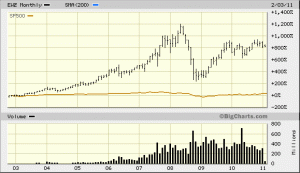Are Emerging Markets Too Risky?
Emerging Markets were the single best place to be from the lows in late 2002 through the top in 2007. In fact, the Brazil ETF – EWZ for example went up a whopping 1200% from 10/2002 – 5/2008 which is absolutely unbelievable for a stock market index. After performance like that many people believed that the only place to be for growth is in the emerging markets. You can see why when you look at this comparison to the S&P 500 ( the S&P 500 is that flat line ).
However, when the down turn came the emerging markets were hit harder than the developed markets so anyone who was late to the party had to endure an incredible amount of pain. In general, the markets or stocks that have the most upside potential are often the same ones that have the most downside potential. These types of investments are known as “High Beta” and even though they can be a valuable part of your portfolio, you need to understand how to manage the risks.
The second half of 2010 was good for emerging markets they had an improving world economy and relatively low interest rates which is a perfect environment. This combined with a flood of liquidity from the Federal Reserve provided plenty of fuel for them to rally. However, 2011 has been a different story so far as soaring food prices and commodity costs have caused problems for emerging countries. The problems stem from the fact that citizens of emerging markets spend a much higher percentage of the income on food costs. With food costs reaching all time highs, these relative poor consumers are feeling the strain. Most of the emerging markets have given up all the gains from the second half of 2010 and are now testing support levels.
The key to success in the emerging markets is to keep them a relatively small portion of your overall portfolio and avoid making emotional decisions. Setting up a proper Asset Allocation Model and re-balancing your portfolio at least annually is the best way to manage your risk.
The following is just an example of what an asset allocation model might look like, it’s not necessarily right for you.
30% U.S. Stocks ( 50% Large Cap – 50% Small Cap )
30% Foreign Stocks ( 60% Developed – 40% Emerging )
10% High-quality Corporate Bonds
10% High-yield Bonds
10% U.S. Treasury bonds (TIPS)
5% Real estate stocks
5% Gold and precious metals
Then at the end of each year (quarterly or even monthly) evaluate your portfolio, selling some of the assets that have inflated and buying the ones that make up a smaller percentage than they should. By doing this you tend to sell over valued assets and purchase under valued ones. When it comes to choosing your investments it may also be valuable to use ETFs like an emerging markets etf instead of trying to choose which individual countries to invest in. The whole point is to take as much of the guess work as possible out of the equation.

